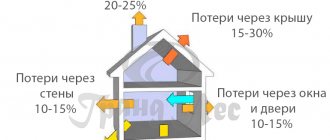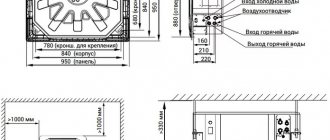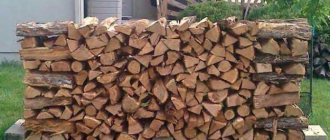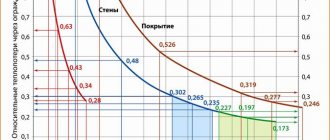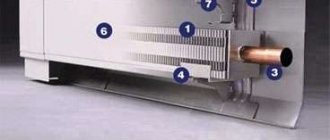Recently, more and more often, with regard to wall-mounted household air conditioners, the question arises of whether they can be used in winter, and how effective the heating function is at this time of the year. In European countries, air conditioners have long been used not only as air cooling in summer, but also used as a full-fledged and economical heating device for living quarters in the cold season. Why? But because the cost of energy resources, in this case we are talking about electric energy, increases every year and becomes a fairly tangible cost item. It is known that air conditioners are several times more efficient than electric heating systems, which is why they began to be used as heating.
The principle of operation of modern split systems
All climatic devices work according to the same principle, based on the property of liquids to release heat during condensation and absorb it during evaporation. Initially, all manufactured systems worked only for cooling, but today most of them are also equipped with a heating function.
In the photo: The principle of the air conditioner
The operation of the air conditioner is based on the functioning of a closed system: the compressor, condenser and evaporator are interconnected by copper tubes that form a refrigeration circuit. The refrigerant is continuously moving along this circuit, transforming from a gaseous state to a liquid and vice versa. When the equipment is operating for cooling, freon enters first into the condenser, and then into the evaporator, where it is again converted into gas and absorbs heat from the air in the room, after which it is sent to the external unit, from where it transfers energy to the environment. When working for heating, thanks to a special valve, the process takes place in the reverse order - from the evaporator to the condenser with the transition of the gas to the liquid state.
Equipment types
To understand how heating is possible with the selected air conditioner of a particular model, it is important to understand their main types.
Inverter
Such devices are distinguished by the continuous functioning of internal mechanisms. Unlike conventional models, which heat or cool the air to a predetermined level and turn off, these first bring the microclimate to the desired state, and then go into the minimum speed mode. This allows you to constantly maintain the required temperature without fluctuations.
It is quite profitable to use an inverter air conditioner for heating an apartment or house. Its operation is economical, since 90% of the time it works in the mode of minimum energy consumption. In addition, the number of compressor starts is significantly reduced, which extends its resource and reduces the load on the power grid. Also, constant work at low speeds does not allow the external mechanisms to freeze up in frost.
Duct
This is equipment with a hidden installation method, where only diffusers and grilles remain in sight. The movement of streams is carried out through a network of air ducts from the main indoor unit, which is connected to the outdoor copper pipes. The devices are ideal for working in large rooms, as they are distinguished by significant power and productivity. A duct air conditioner can also be used to heat a house, in this case it can be used alone for several rooms or even floors.One of its most important advantages is the ability to evenly distribute heat in space due to a well-designed air duct network.
Among the disadvantages of the equipment, the complexity of installation is distinguished, which is better to entrust to competent specialists, the need to place communications under the lining of the ceiling, for which you will have to lower its level a little.
Air conditioner operation in winter in heating mode
Now let's move on to the main thing and find out if it is possible to run a split-system to heat a room when there is a significant "minus" outside.
At what external temperatures is it possible to work in heating mode
Most modern air conditioners can work for heating only if the temperature outside the window is not lower than -7 ° C ... -15 ° C. More accurate information on the lower temperature threshold can be found in the instructions for the device. If you use the device at lower thermometer readings, the heating power will be less. In addition, there will be a threat of icing of the drainage system and the condenser, which will inevitably lead to a breakdown of the entire split system.
In the photo: The principle of operation of modern split systems
But depending on the refrigerant and the type of compressor, some air conditioners can operate in heating mode and at lower temperatures, for example, -15 ° C ... - 30 ° C. We are talking about advanced models of inverter split systems.
For what reasons, the air conditioner does not work for heating
If the device provides the ability to work for heating the room, but it does not turn on in this mode, it is possible that the compressor, drainage system or valve that switches the refrigeration circuit to heating has failed. There is also a possibility of refrigerant leakage at the joints of the pipes. In this case, it is worth calling a repairman for HVAC equipment.
Another popular reason is that the temperature outside the window is below the acceptable minimum, so the air conditioner can only slightly increase the level of heat in the room.
If the device works fine, but the air in the room does not heat up, then it may just be worthwhile to wait a little - sometimes the system needs additional time for the indoor unit to warm up. In winter, this is quite normal.
The display of the indoor unit, which displays error codes in the operation of the split system, can also help to understand the causes of the malfunction.
If you cannot install and fix the problem yourself, it is better to contact a specialized service center.
Restrictions on heating the house with air conditioning
A significant limitation for using the air conditioner as a heating device is the limit value of the negative outside temperature for its normal operation for heating (this characteristic is necessarily indicated in the passport data). This parameter indicates that at temperatures below a certain level, stable operation of the equipment is not guaranteed at all.
The second no less important nuance is the drop in equipment performance when the outside temperature drops. The fact is that thermal performance and energy efficiency in terms of heat (COP coefficient - the ratio of heat released to consumed electricity) is normalized at a certain outdoor temperature (usually + 7 ° C), and when it decreases, these indicators worsen.
So, for example, a conventional inverter split system, having an energy efficiency factor of 4, generates 4 kW of heat per 1 kW of consumed electricity at + 7 ° С, but already at -10 ° С its energy efficiency will decrease to 1.5-2, and at -15 ° C, it will generally only be around 1.
Today, only air-to-air heat pumps, specially designed for heating in low temperatures, have an energy efficiency coefficient that does not fall below 2 even at -25 ° C outside the window.
Air conditioner operation in winter in cooling mode
Room cooling using a split system is permissible only if the outside temperature is not lower than + 16 ° C or meets other permissible values specified in the equipment operating manual. In all other cases, turning on the air conditioner in order to lower the temperature in the room is prohibited and threatens with ice formation and water leakage from the indoor unit.
In the photo: Ice formation and water leakage from the indoor unit.
If there is a need to maintain a low temperature even in winter, then it is better to install a special system capable of operating at wider temperature values.
Another option is to modify the air conditioner with a special winter kit, which will provide great opportunities for operating the device in cold weather.
The principle of operation of the air conditioner in the room
Home> Articles> Communications> Ventilation
Considering the principle of operation of an air conditioner in a room, we can safely say that it is similar to the operation of a refrigerator, which uses such physical properties of liquefied gas as the absorption of heat at the moment of evaporation and its release during condensation. The operation of the air conditioning device is based on a change in the aggregate state of the refrigerant. Its role is usually played by the hydrofluorocarbon HCFC with a boiling point of 40.8 ° C, at a pressure of 760 mm Hg. Art.
How does the simplest split system work?
To better understand the principle of operation of such a device, consider a split system, which is designed only for air cooling. It consists of an outdoor and indoor unit. The outdoor one is located on the street, it is equipped with a compressor that circulates the refrigerant. The process is as follows: the refrigerant entering the circuit of the indoor unit has a low pressure, since when it passes from the outdoor unit, it goes through a throttling process (i.e. pressure reduction).

The temperature of the refrigerant reaches values from 5 to 10 ° C, it begins to boil, turns into a vaporous state. The required amount of heat energy is taken from the air that gets from the room to the heat exchanger installed in the indoor unit. Then the fan turns on, directing the cooled air back into the room.
The refrigerant, which is in the vapor state at this time, enters the outdoor unit and is strongly compressed with the help of the compressor. The pressure begins to rise, the temperature rises, reaching 50-60 ° C. Then the steam cools down, and when it goes into a new state of aggregation (liquid), it releases heat, supplied to the heat exchanger, and the air begins to heat up.
After leaving the heat exchanger, the refrigerant again passes through the capillary tube, it throttles, the temperature again drops to a value of 5-10 ° C. The liquid boils again, absorbing thermal energy from the air coming from the room.
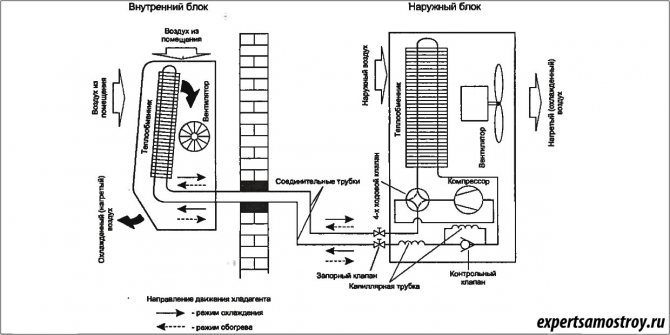

On the operation of a more complex air conditioning system
The operation of a split system, which is capable of not only cooling, but also heating the room, is more complex, although it is based on the same principles. When the operating mode changes from "cooling" to "heating", the outdoor and indoor units are also swapped. In order to be able to change the direction of the refrigerant in the circuit, a special 4-way valve is activated.
When operating in cooling mode, the liquefied gas, which has high values in temperature and pressure, is directed by the valve, and enters the outdoor unit to the heat exchanger.When switching to heating mode, the same valve directs the gas to the indoor unit, falling on its heat exchanger.
When the "heating" mode is on, the direction of gas movement is changed by the valve, and the compressor is connected to work. It sucks gas from the outdoor unit, then starts pumping it into the indoor unit. Once in the heat exchanger, the gas condenses, giving off heat energy and heating the room. The condensate throttled in the capillary tube, getting into the outdoor unit, again makes a transition to a gaseous state, and then is sucked in by the compressor.
This cycle, constantly repeating, raises the room temperature to the desired values. The configuration of the contour of the split system, which includes several indoor units, is much more complicated. Two compressors operate in it at once, circulating gas in the internal blocks. In this case, the compressor of the outdoor unit is common.


Heat pump
The heating mode provides for the intake of heat from the outside air, and pumping it into the room, this method became known as a "heat pump". A drop in the outside temperature makes it difficult to absorb heat, and the heating capacity and heating speed are reduced. For this reason, the use of heating is not recommended when the temperature becomes lower than -5 ° C. Under these conditions, energy consumption increases, cooling efficiency decreases and the compressor wears out faster.
How the efficiency of an air conditioner is calculated
It is considered a misconception that when operating in heating (heat pump) mode, the efficiency can be higher than 100%. In this case, it is better to talk about the efficiency of the air conditioner, and not about its efficiency.
To better understand this issue, it is proposed to consider such an example. There are two media: “hot” with temperature T1 and “cold” with temperature Tₒ, (T1 ≥ Tₒ). During the cycle of converting heat with a higher temperature (Q1) into work (L), part of the heat will certainly go to a lower level, where the temperature is Тₒ. Thus, the heat energy Q1 of the heater having the temperature T1 is taken from it, and the heat energy Qₒ is transferred to the refrigerator with the temperature Tₒ. In accordance with the law of conservation of energy, Q1 = L + Qₒ, and the efficiency of the direct heat power cycle is calculated as follows: k = L / Q1. The efficiency factor of such a cycle can be calculated by the formula f = Q1 / L. If we assume that there is no energy loss, then the efficiency factor will be f = Т1 / (Т1 - Тₒ).
It turns out that the smaller the difference between the temperatures T1 and Tₒ, the higher the efficiency coefficient. As mentioned above, this example proves that a decrease in the outdoor temperature leads to a decrease in the efficiency of an air conditioner running for heating.
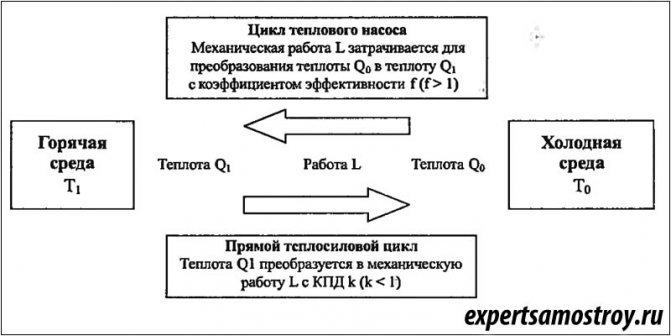

Why does an air conditioner need heating elements?
Since there is a significant decrease in performance in the heat pump mode, when the outside temperature drops, air conditioner manufacturers install electric heating elements (TENs) for additional heating. Their power ranges from 1.5 to 3 kW, and they turn on automatically, with a difference of no more than 3 degrees between the actual and the set temperature.
Practice shows that if the performance is correctly selected and the required temperatures are adequately set, the heating element works only for a few minutes. If the outside air temperature drops below -10 ° C, and the performance drops sharply by 35-50%, the heating element is able to compensate for such a drop and accelerate the heating time.
Dehumidification mode
In addition to such useful functions as room cooling and heating, air conditioners carry out ventilation and dehumidification, their operation is possible in automatic mode. Dehumidification usually accompanies air cooling. When it gets from the room onto the evaporator, it condenses moisture.Switching on to the dehumidification mode significantly accelerates the condensation process, while the humidity of the air entering the room is normalized, and its temperature remains unchanged. This effect is achieved by additional heating of the air when it passes through the evaporator, and then drying it with a heating element.
In what other modes does the air conditioner work?
- Ventilation. This mode does not provide for cooling or heating the air. With it, the fan circulates the entire volume of air in the room. If there are special filters, it is cleaned. The outdoor unit is not involved in operation. It is possible to change the fan speed from the remote control.
- Auto mode. A comparison is made between the values of the actual temperature in the manned room and the set one. Comparing these values, the air conditioner independently determines its further actions: leave the existing operating mode or switch to another mode ("cooling" or "heating").
In split systems designed for cooling only, there is a choice between cooling and dehumidification in automatic mode.
Nowadays, it is difficult to imagine life without such wonderful, smart and very necessary devices as air conditioners. Every year their technical characteristics improve, their functionality increases, and the cost becomes more and more affordable.
What is a winter kit and what is it for
The winter kit is a set of special devices that ensure the safe operation of the air conditioner at temperatures below the range specified by the manufacturer. It includes crankcase heating, drain heating, fan speed regulator. With the help of these devices, icing of the drainage system, the formation of ice on the body, thickening of the oil and overcooling of freon are prevented.
In the photo: Winter kit for Dantex air conditioner
But when using a winter kit, it is very important not to forget that air conditioners equipped with it can only work for cooling. Heating in this case is possible only within the temperature range indicated in the technical specifications of the device.
Split heating efficiency
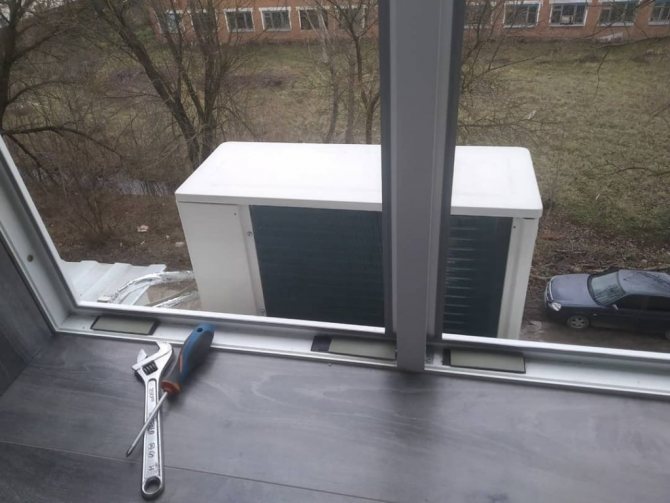

Answering the question whether it is possible and how rationally to heat a house with air conditioning, it is worth comparing it with other types of climatic equipment. Electric models (oil radiators, cannons, infrared panels) convert grid energy into heat in a 1: 1 ratio. Split systems use a free natural resource from the surrounding area. At the same time, they need electricity only to ensure the operation of the compressor, fan and other moving mechanisms. As a result, from 1 kW of consumed energy, they can produce 3-7 kW of heat, which is many times more efficient than traditional equipment.
If we talk about gas boilers, then according to the observations of specialists, they still turn out to be more profitable in operation, since the price of this fuel is lower than that of electricity. But do not forget that these units are more expensive than air conditioners.
What systems can work in heating mode in winter
There are equipment on the modern market that can be safely turned on in winter in heating mode - even when the temperature drops to -15 ° C ... -30 ° C. These are inverter-type split systems. They are distinguished from standard air conditioners by the presence of an inverter compressor, which provides capacity control. The use of an inverter compressor with EVI refrigerant vapor injection and a receiver allows for stable operation at very low ambient temperatures - some models are designed for operation at -30 ° C.
Heat pump equipment
Such an installation is a kind of air conditioner for heating. Its main element is a heat pump.The main feature of this unit is the operation for heating at low temperatures (up to minus 25 degrees). Although the efficiency of heat pumps decreases markedly even when the air temperature drops to 15 degrees. The only downside to air-to-air systems is their dependence on weather conditions and reduced efficiency under adverse conditions.
Water-to-water heat pumps are more reliable, but their cost is much higher.
Preparing the air conditioner for winter
As part of preparing the device for the winter season, it is necessary to carry out a number of preventive measures.
It is necessary to dry the indoor unit from the accumulated condensation. To do this, the air conditioner must first be turned on for a while for cooling, and then started for heating for the same period. Clean built-in filters from accumulated saw and dirt. If conditions permit, install a protective cover on the outdoor unit.
If there is a standard household air conditioner in the room, then it is better to limit it to turning it on in heating mode only during the off-season - until the temperature drops below the limit values set by the manufacturer.
